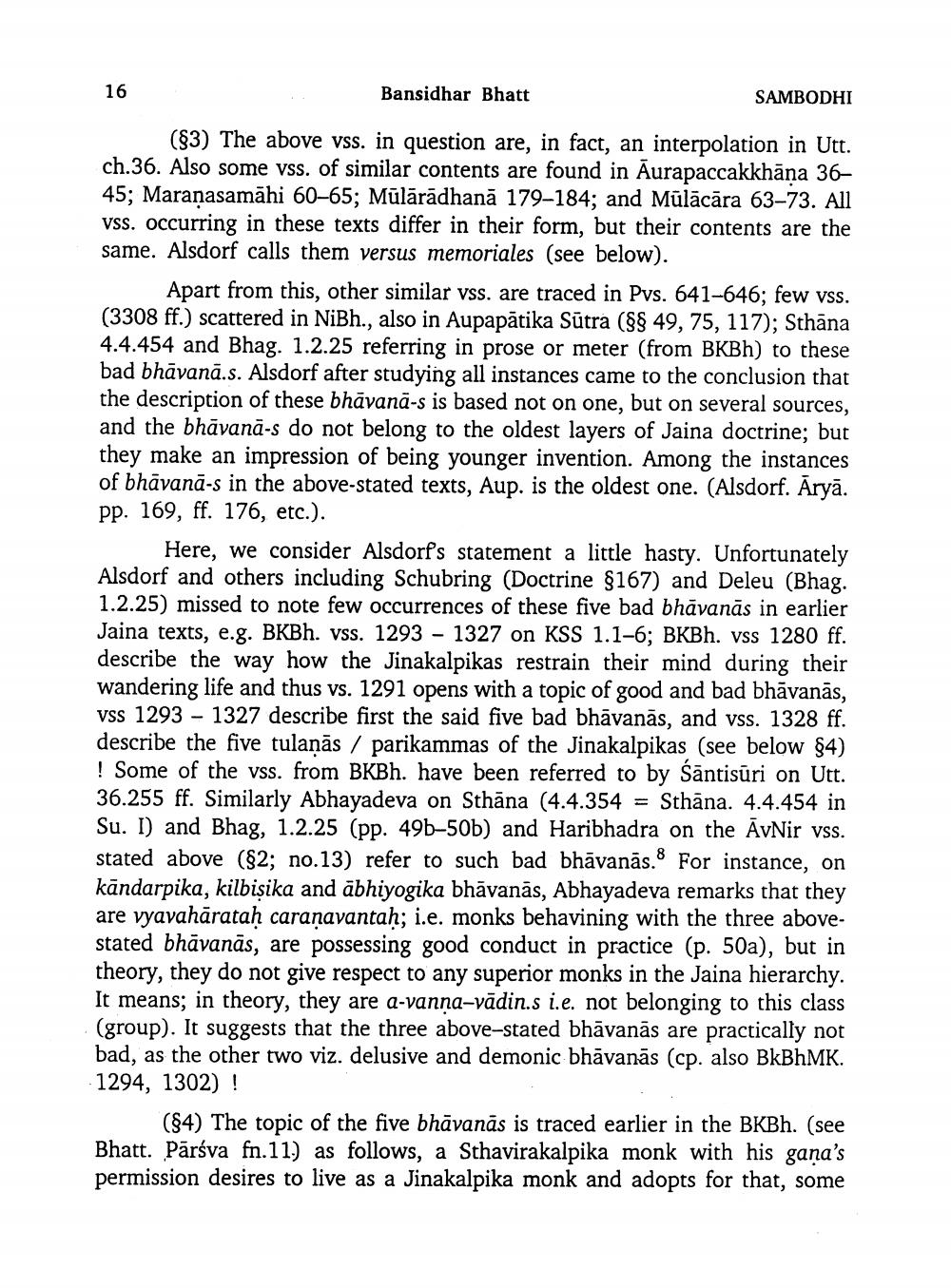________________
Bansidhar Bhatt
SAMBODHI
(83) The above vss. in question are, in fact, an interpolation in Utt. ch.36. Also some vss. of similar contents are found in Aurapaccakkhāna 3645; Maranasamāhi 60-65; Mülārādhanā 179-184; and Mülācāra 63-73. All VSS. occurring in these texts differ in their form, but their contents are the same. Alsdorf calls them versus memoriales (see below).
Apart from this, other similar vss. are traced in Pvs. 641-646; few vss. (3308 ff.) scattered in NiBh., also in Aupapātika Sūtra (S$ 49, 75, 117); Sthāna 4.4.454 and Bhag. 1.2.25 referring in prose or meter (from BKBh) to these bad bhāvanā.s. Alsdorf after studying all instances came to the conclusion that the description of these bhāvanā-s is based not on one, but on severa and the bhāvanā-s do not belong to the oldest layers of Jaina doctrine; but they make an impression of being younger invention. Among the instances of bhāvanā-s in the above-stated texts, Aup. is the oldest one. (Alsdorf. Aryā. pp. 169, ff. 176, etc.).
Here, we consider Alsdorf's statement a little hasty. Unfortunately Alsdorf and others including Schubring (Doctrine 8167) and Deleu (Bhag. 1.2.25) missed to note few occurrences of these five bad bhāvanās in earlier Jaina texts, e.g. BKBh. vss. 1293 - 1327 on KSS 1.1-6; BKBh. vss 1280 ff. describe the way how the Jinakalpikas restrain their mind during their wandering life and thus vs. 1291 opens with a topic of good and bad bhāvanās, vss 1293 - 1327 describe first the said five bad bhāvanās, and vss. 1328 ff. describe the five tulanās / parikammas of the Jinakalpikas (see below $4) ! Some of the vss. from BKBh. have been referred to by Säntisūri on Utt. 36.255 ff. Similarly Abhayadeva on Sthāna (4.4.354 = Sthana. 4.4.454 in Su. I) and Bhag, 1.2.25 (pp. 496–50b) and Haribhadra on the AvNir vss. stated above ($2; no.13) refer to such bad bhāvanās. For instance, on kāndarpika, kilbisika and ābhiyogika bhāvanās, Abhayadeva remarks that they are vyavahārataḥ caraṇavantah; i.e. monks behavining with the three abovestated bhāvanās, are possessing good conduct in practice (p. 50a), but in theory, they do not give respect to any superior monks in the Jaina hierarchy. It means; in theory, they are a-vanna-vādin.s i.e. not belonging to this class (group). It suggests that the three above-stated bhāvanās are practically not bad, as the other two viz. delusive and demonic bhāvanās (cp. also BkBhMK. 1294, 1302) !
(84) The topic of the five bhāvanās is traced earlier in the BKBh. (see Bhatt. Pārśva fn.11.) as follows, a Sthavirakalpika monk with his gana's permission desires to live as a Jinakalpika monk and adopts for that, some




